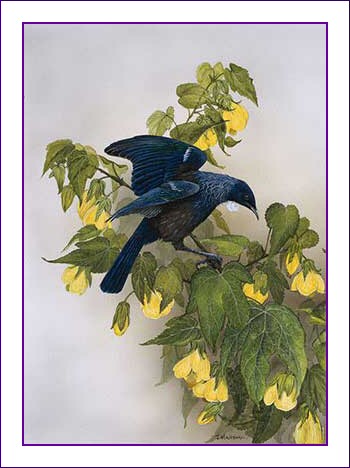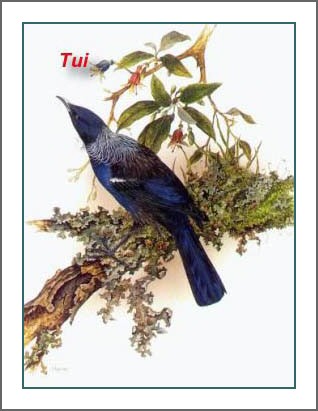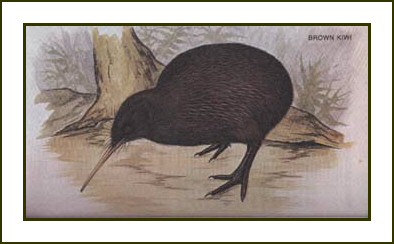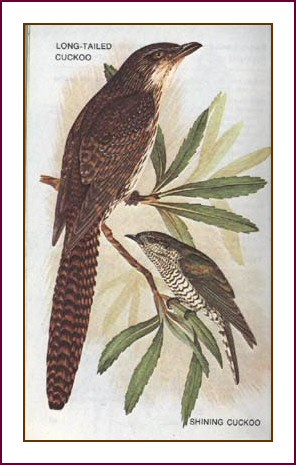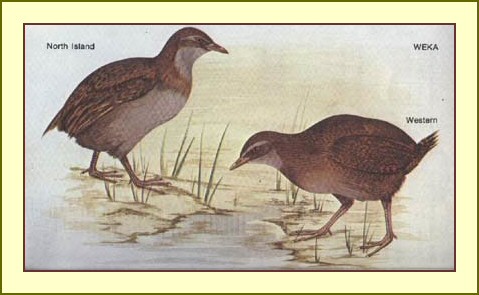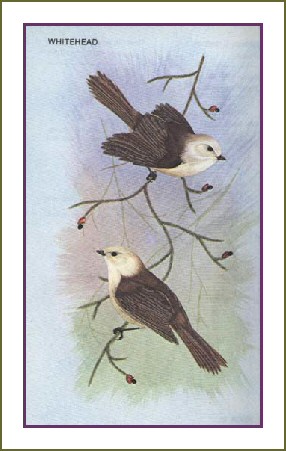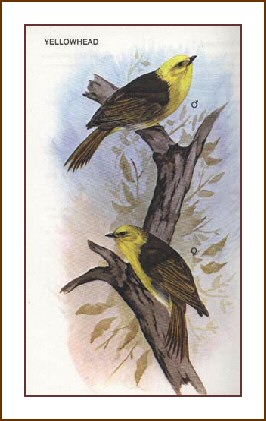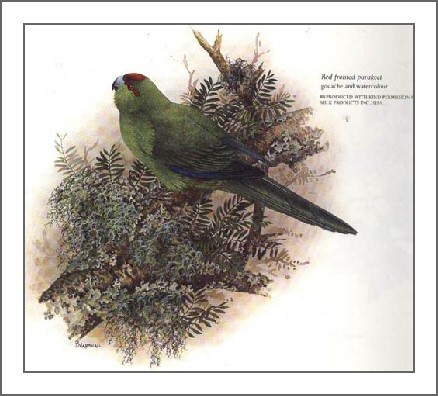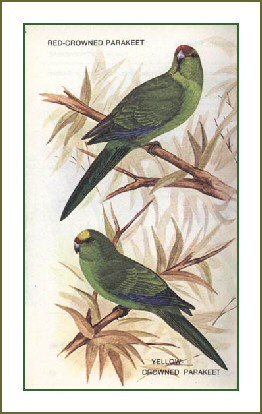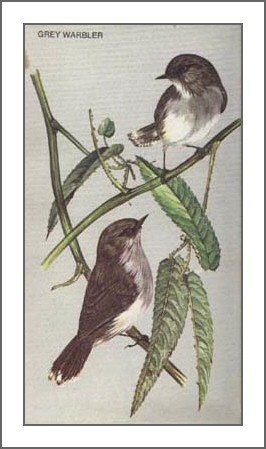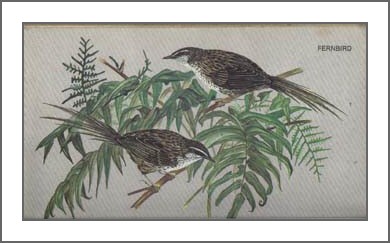

SCROLL DOWN TO FIND MORE BUSH BIRDS:
![]()
 (from
K is for KIWI,Reed)
(from
K is for KIWI,Reed)
There are so many things that begin with C, like caterpillars, cuckoos and crabs. Chrysalis that dangle, soon to be free, clematis that hangs from the top of a tree. A cranefly, a crake or a crack in the wall, they all have their place, wether large or small, they are part of the chain that links us all.
TUI; BROWN KIWI; SHINING AND LONG TAILED CUCKOO; WEKA; WHITEHEAD; YELLOWHEAD; RED AND YELLOW FRONTED PARAKEETS - GREY WARBLER - FERNBIRD.
![]()
TUI
|
|
|
TUI Prosthemadera novaeseelandiae FAMILY: Melifagidae
Endemic to NZ with one closely related sub-species.
Fully protected. Found throughout NZ up
to 1000mts. Mainly in native forest remnants,
gardens and parks. Rare in pure beech forest. The
Tui is slightly larger than the Blackbird, with a prominent white wing
patch and
throat tuft (this white tuft giving the bird the name 'Parson Bird'
by NZ pioneers). Known for its beautiful
bell-like call similar to the Bellbird, but with harsher tone and
croaks and gurgles. Their wings make a loud whirring
sound when in flight. Feeds on berries, nectar, fruit
and insects. The forehead is often stained with
pollen, especially when feeding on flax flowers. Breeding
is from October to January, with possibly 2 broods being reared.
The nest is a bulky structure of twigs and sticks lined
with fine grass, feathers and moss. The eggs, 3-4, are
pinkish-white with red-brown spots and blotches densest at the larger
end. .![]()
BROWN KIWI
|
BROWN KIWI/Kiwi Apteryx australis FAMILY: Apterygidae The Kiwi is endemic to NZ and is fully protected. There are 3 sub- species, North Island [shown in plate] South Island and Stewart Island. Nth. Island is darkest with dark legs. Sth. Island is lighter with pale flesh coloured legs. Found throughout NZ in native bush, second growth and scrubland, but rarer in the Sth. Island and is not seen west of the main divide. Also becoming scarce in the North Island. Kiwi feed at night on worms, insects, seeds and berries, most located by smell. They stay in burrows underground or beneath trees during the day. Their call is an often repeated shrill whistle 'ki-weee' in the male, hoarse and lower pitched in the female. Kiwi breed throughout the year especially July to February. They nest in hollow logs, in holes in banks and under tree roots. The eggs, 1-2, are smooth ivory white or greenish-white, and very large for the size of the bird. The male only incubates and cares for the young. Unlike most birds, Kiwi have their nostrils placed at the tip of their long bill. NOTE: The LITTLE SPOTTED KIWI - [Apteryx oweni] and GREAT SPOTTED KIWI [Apteryx haasti] are found in the South Island mainly west of the main divide. They are grey, banded and mottled with brownish-black. They are respectively the smallest and largest of the Kiwis.
LONG-TAILED AND SHINING CUCKOOS |
||
|---|---|---|
|
||
|
WEKA Gallirallus australis FAMILY: Rallidae Endemic to NZ with 4 closely related sub-species, Nth Island; Western; Buff and Stewart Island. North Island and Western are depicted. Fully protected except on Chatham Islands. The Weka is an inquisitive bird, flightless, with a measured walk, flicking tail and rapid run. Nth Island- restricted to Gisborne, Poverty Bay, but introduced elsewhere. Western Weka are found in the Sth Island mainly west of the main divide. Buff Weka were previously in Canterbury but now restricted to the Chatham Islands. Stewart Island Weka are present on Stewart Island and other southern islands where they were introduced by fishermen, whalers, sealers and muttonbirders. They feed on a variety of vegetable and animal matter, insects, worms, crustacea, rats and mice, fruit, eggs and chicks of ground nesting birds. Breeding is usually from September to April, but sometimes 3-4 times per year. The nest is a shallow cup of woven grass under scrub, tussock, raupo. The eggs, 3-6, are creamy-pink with scattered mauve blotches. WHITEHEAD |
||
YELLOWHEAD/ Mohua Mohoua ochrocephaia FAMILY: Muscicapidae The Yellowhead is endemic to NZ and fully protected. They are locally common in South Island beech forest, and frequent dense native bush canopy, feeding on insects in foliage and debris collected in tree forks and bark. Occasionally they will feed on the ground. Breeding is from November to December. The nest is cup-shaped and made of moss, rootlets and spiders' web and lined with fine grasses, in holes in dead trees. The eggs, 3-4, are pinkish-white and evenly blotched with reddish-brown. The female only incubates and they are sometimes host to the Long-tailed Cuckoo.
RED AND YELLOW-FRONTED PARAKEETS
RED-CROWNED PARAKEET/Kakariki Cyanoramphus novaezelandiae FAMILY: Platycercidae Native, also found in New Caledonia. There are several closely associated sub-species in the NZ region. Fully protected. These are a small parrot, about the size of a Blackbird, with rapid wing beat, swift straight flight and a chattering call mainly when in flight. Found throughout NZ in large areas of native bush, but more plentiful on outlying islands. They feed on a wide variety of vegetable matter, from fruits and seeds to leaves and buds. They are commonly held in aviaries under permit. Breeding is from October to March, and the eggs, 4-9, white, are deposited in hollow trees and rock crevises.
YELLOW-FRONTED PARAKEET/Kakariki Cyanoramphus auriceps FAMILY: Platycercidae Endemic with one other closely related sub-species, the Orange Fronted Parakeet. Smaller than the Red-Crowned Parakeet and more plentiful and widespread on the mainland. Food and nesting is similar to the Red-Crowned. Breeding is from August to April and the female only incubates the eggs. Also commonly held in aviaries under permit.
GREY WARBLER
GREY WARBLER/ Riroriro Gerydone igata FAMILY: Muscicapidae Endemic with closely related species in the Chatham Islands. Fully protected. Small bird with conspicuous white tip to tail when in flight. Warblers are more commonly heard than seen, their song being a penetrating high melodious rising and falling trill. They are very active birds and will sometimes hover near foliage when searching for food. Common throughout NZ but absent from open country and high alpine areas. Their food consists of spiders, insects and larvae. Breeding is from August to December with usually two clutches. The nest is a hanging, pear-shaped structure with a small side entrance, constructed of moss, grass and spiders' web, lined thickly with feathers. The eggs, 3-5, are pinky-white, dotted all over with brown. The Warbler is a favourite host of the Shining Cuckoo, who lays its egg with the second clutch. The Warbler then incubates and raises the chick. FERNBIRD
FERNBIRD / Matata Bowdleria punctata FAMILY: Muscicapidae Endemic to NZ with 6 sub-species. Fully protected. Found throughout NZ but becoming localised through loss of habitat, which includes swamps, wetlands, scrubland and bracken. Not alpine. Fernbirds feed on insects. Breeding is from September to February and the nest is neatly woven of grasses and rushes, with a deep cup lined with feathers. It is well hidden a few centimetres from the ground or above stagnant water. The eggs, 2-3, are pinkish-white covered in brown dots which are concentrated at the larger end.
|

Copyright(c) 2006 Janet Marshall. All rights reserved.
myid@myhost.com
nbsp;
nbsp;




















